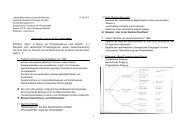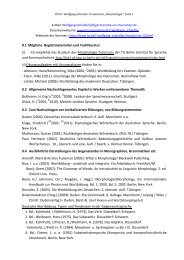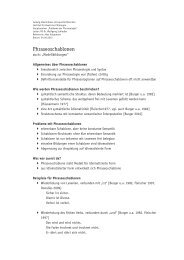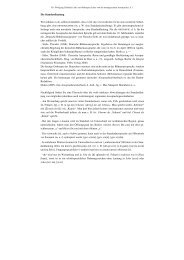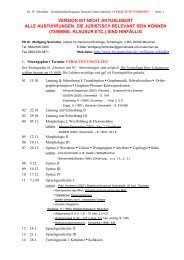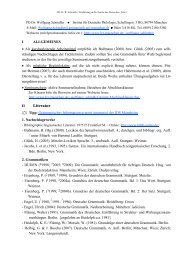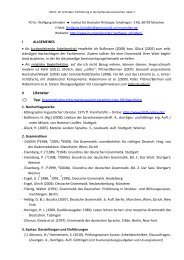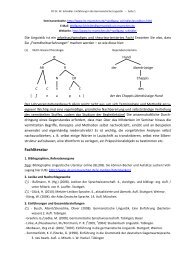Chapter 18 Lexical Functions: Description of Lexical Relations in a ...
Chapter 18 Lexical Functions: Description of Lexical Relations in a ...
Chapter 18 Lexical Functions: Description of Lexical Relations in a ...
Create successful ePaper yourself
Turn your PDF publications into a flip-book with our unique Google optimized e-Paper software.
—<strong>Chapter</strong> <strong>18</strong>. <strong>Lexical</strong> <strong>Functions</strong>— 35<br />
relation, so that if L´ is a hyperonym <strong>of</strong> L <strong>in</strong> L, the translation <strong>of</strong> L´ will be a hyperonym <strong>of</strong> the<br />
translation <strong>of</strong> L <strong>in</strong> any other language. But the LF Gener models a LEXICAL relation, and it is<br />
required that the elements <strong>of</strong> its value satisfy a particular textual-syntactic condition: Gener(L)<br />
must be admissible <strong>in</strong>to certa<strong>in</strong> constructions <strong>in</strong> L; namely, the elements <strong>of</strong> its value must be able<br />
to appear <strong>in</strong> at least one <strong>of</strong> the follow<strong>in</strong>g two constructions:<br />
1) Gener(L)−ATTR→DER(L) [where DER is any structural derivation, see below, Nos. 7-10].<br />
The mean<strong>in</strong>g <strong>of</strong> the whole expression must be the same as that <strong>of</strong> L:<br />
(Gener(L)−ATTR→DER(L)) = (L).<br />
2) L, X1, X2, ..., Xn and other (k<strong>in</strong>ds <strong>of</strong>) Gener(L).<br />
Semantically, L is not restricted. Syntactically, L can be <strong>of</strong> any part <strong>of</strong> speech, but most<br />
commonly, it is a noun. Gener has the part <strong>of</strong> speech <strong>of</strong> L. The elements <strong>of</strong> the Gener(L) value<br />
normally comb<strong>in</strong>e with L (or L’s structural derivation) <strong>in</strong> the text (i.e., they are non-fused), yet it<br />
is a typical paradigmatic LFs: it is used to construct a complex name for an entity or a situation.<br />
Examples<br />
Gener(republic) = state [republican state = republic]<br />
Gener(liquidN) = substance [liquidA substance = liquidN]<br />
Gener(carrots) = vegetables [carrots, sp<strong>in</strong>ach, zucch<strong>in</strong>i and other vegetables]<br />
Gener(arrestN) = reprisals [arrests and other (k<strong>in</strong>ds <strong>of</strong>) reprisals]<br />
Gener(whisperV) = say [say <strong>in</strong> a whisper = whisperV ]<br />
Gener(yellowA) = color [yellow, green and other colors]<br />
6. Figur [Lat. figuraliter (figuratively)] = standard metaphor<br />
L´ which is Figur(L) is a clichéed, automatic metaphor for L; the elements <strong>of</strong> the Figur<br />
value appear <strong>in</strong> the construction Figur(L)−I→L, so that Figur(L) is used <strong>in</strong> the text together<br />
with L, form<strong>in</strong>g a collocation. The mean<strong>in</strong>g <strong>of</strong> this collocation is roughly equal to that <strong>of</strong> L:<br />
(Figur(L)−I→L) ≈ (L).<br />
Semantically, L can be anyth<strong>in</strong>g; syntactically, L and Figur(L) are both nouns.<br />
Examples<br />
Figur(remorse) = pangs [pangs <strong>of</strong> remorse ≈ remorse]<br />
Figur(passion) = flame [flame <strong>of</strong> passion ≈ passion]<br />
Rus. Figur(blokada) = kol´co [kol´co blokady lit. (r<strong>in</strong>g <strong>of</strong> blockade) ≈ blokada (blockade)]<br />
Rus. Figur(tuman) = pelena [pelena tumana lit. (shroud <strong>of</strong> fog) ≈ tuman (fog)]


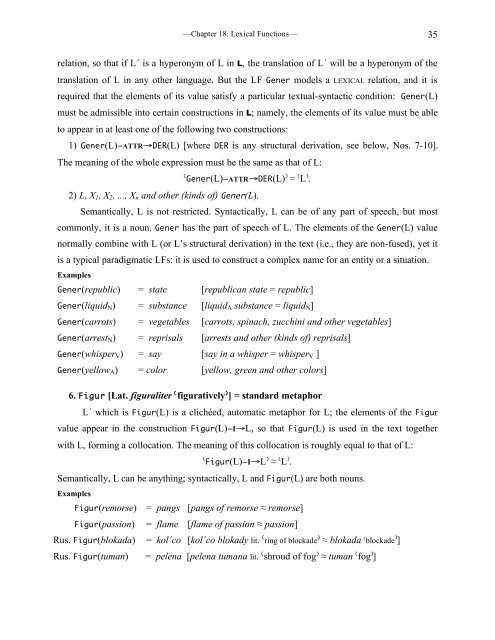
![E-Mail: Wolfgang.Schindler[ätt]germanistik.uni-muenchen.de Web ...](https://img.yumpu.com/51590147/1/184x260/e-mail-wolfgangschindlerattgermanistikuni-muenchende-web-.jpg?quality=85)
